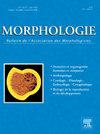Temporomandibular joint disorder: Etiologies and treatments (part 2)
Q3 Medicine
引用次数: 0
Abstract
Temporomandibular joint (TMJ) disorders (TMDs) are complex conditions affecting the joint and associated musculoskeletal structures, causing pain and functional impairment. This review explores the anatomical basis, etiological factors, and therapeutic strategies for TMD, emphasizing the interplay between TMJ anatomy, pathophysiology, and treatment outcomes. Myogenous and arthrogenous TMDs present distinct anatomical challenges, requiring targeted interventions. Key findings highlight the efficacy of conservative therapies, including behavioral interventions, physical therapies, and occlusal splints, as first-line treatments, followed by low-level laser therapy (LLLT), transcutaneous electrical nerve stimulation (TENS), and dry needling for myofascial pain. Botulinum toxin-A (BoNT-A) (De la Torre Canales G et al., 2024 [1]) is effective for persistent myogenous TMD but reserved for cases unresponsive to first-line treatments. Emerging therapies, such as platelet-rich plasma (PRP) and 3D-printed implants, show promise for refractory cases. This review aims to advance the understanding of TMD from an anatomical perspective, providing evidence-based insights for clinicians and researchers. Part 1 of this series, “Temporomandibular Disorder: The Anatomy of Pain”, details TMJ anatomy and pain pathways, forming the foundation for this analysis.
颞下颌关节紊乱:病因和治疗(第二部分)
颞下颌关节(TMJ)疾病(TMDs)是影响关节和相关肌肉骨骼结构的复杂疾病,可引起疼痛和功能障碍。本文综述了颞下颌关节病的解剖学基础、病因及治疗策略,强调了颞下颌关节解剖、病理生理和治疗结果之间的相互作用。肌源性和关节源性tmd存在不同的解剖学挑战,需要有针对性的干预。主要研究结果强调了保守治疗的有效性,包括行为干预、物理治疗和咬合夹板作为一线治疗,其次是低水平激光治疗(LLLT)、经皮神经电刺激(TENS)和干针治疗肌筋膜疼痛。肉毒毒素- a (BoNT-A) (De la Torre Canales等人,2024 b[1])对持续性肌源性TMD有效,但只适用于对一线治疗无反应的病例。新兴疗法,如富血小板血浆(PRP)和3d打印植入物,显示出对难治性病例的希望。本文旨在从解剖学角度加深对TMD的理解,为临床医生和研究人员提供基于证据的见解。本系列的第1部分“颞下颌紊乱:疼痛的解剖”详细介绍了颞下颌关节解剖和疼痛通路,为本分析奠定了基础。
本文章由计算机程序翻译,如有差异,请以英文原文为准。
求助全文
约1分钟内获得全文
求助全文
来源期刊

Morphologie
Medicine-Anatomy
CiteScore
2.30
自引率
0.00%
发文量
150
审稿时长
25 days
期刊介绍:
Morphologie est une revue universitaire avec une ouverture médicale qui sa adresse aux enseignants, aux étudiants, aux chercheurs et aux cliniciens en anatomie et en morphologie. Vous y trouverez les développements les plus actuels de votre spécialité, en France comme a international. Le objectif de Morphologie est d?offrir des lectures privilégiées sous forme de revues générales, d?articles originaux, de mises au point didactiques et de revues de la littérature, qui permettront notamment aux enseignants de optimiser leurs cours et aux spécialistes d?enrichir leurs connaissances.
 求助内容:
求助内容: 应助结果提醒方式:
应助结果提醒方式:


